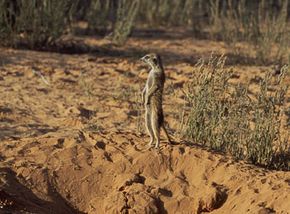Quck answer
Meerkats exhibit cooperative behavior within their social groups, including sharing food and caring for young. While this behavior may appear generous, it is driven by the benefits it provides to the group as a whole, rather than individual generosity. Meerkats are ultimately motivated by survival and reproduction, and their cooperative behavior helps to ensure the success of the group. Therefore, while meerkats may display cooperative behavior, it is not necessarily a result of inherent generosity.

For centuries, there has been a debate about whether true altruism exists among humans. An altruistic act is one that a person performs for the benefit of others, but to their own detriment. Immanuel Kant, an 18th-century Prussian philosopher, suggested that there is no such thing as altruism since the giver always receives something in return, even if it is just a sense of well-being. However, people still perform altruistic acts, and the same is true in the animal kingdom. The question is, why do some animals exhibit generosity?
Meerkats are one of the most cooperative species in the animal kingdom, making them the perfect subjects for an investigation into altruism. They live in a harsh habitat, at the bottom of the food chain, and their food and water sources require a lot of effort to obtain. Despite this, meerkats have developed tight-knit societies that consistently display random acts of kindness, which is surprising since their ancestors, the mongooses, are solitary creatures.
Meerkat Altruism

When meerkat pups are still young, they learn to take care of themselves. An older meerkat will teach them how to find food, which is mostly insects. However, the pups are not yet fully able to feed themselves, so they beg for food from the foraging adults. Interestingly, the adults always feed the pups, even if they are not their own offspring.
Meerkats are known for their altruistic behavior within their gangs. Despite being foragers who eat on a daily basis, they share their food with the young members of the gang. It is interesting to note that the adult offering food is not always the parent of the pup. The dominant male and female rule the gang, but the subservient meerkats also play a crucial role in raising the young. These acts of generosity are risky and do not provide any apparent benefits. For example, meerkats take turns to stand guard as sentinels, sacrificing valuable time to forage for food. However, this act of altruism was explained by a study that showed sentinels were the best positioned to escape danger. Meerkat pups are also cared for by subservient meerkats in their gang, as the mother is often off foraging. Meerkats’ altruistic behavior is a unique characteristic that sets them apart from other animals.
Female meerkats who are dominant are thought to engage in a behavior that guarantees the survival of their offspring. If they can remain healthy and well-fed, they are more likely to produce healthy pups for years to come. While the mother is foraging for food, her helpers care for her young. Similarly to standing guard, caring for newborns appears to be altruistic. However, caregiving among meerkats is more complex. Some meerkats are more likely to be helpful than others. Caregiving results in less time to forage for food and is more dangerous than standing guard. A subservient female who cares for pups that aren’t her own can lose a lot of weight and puts herself and the young at risk of attack from predators or rival gangs. It is puzzling that a subservient female who babysits meerkat pups may already be lactating. Nursemaids feed the pups from their own bodies, and spontaneous lactation among females that haven’t recently been pregnant has been observed. However, the lactating female has usually recently been pregnant and has lost her own pups, usually due to the same dominant female for whose pups the nursemaid is caring. The dominant/subservient social structure of meerkat society explains some of this generous behavior. However, serving as a nursemaid appears to be entirely altruistic, and there is no reward, only risk. Meerkats are not examining altruism with the same enthusiasm as philosophers, so it is possible that humans are projecting their own values onto these small creatures. For more information on meerkats, altruism, and other related topics, visit the next page.
Additional Information
Related Articles from HowStuffWorks
- Is it possible to perform a completely selfless act?
- What is the ultimatum game?
- Explanation of Natural Selection
- Explanation of Evolution
- Explanation of the Digestive System
- Explanation of Philanthropy
- Explanation of Breastfeeding
- Eagle
More Useful Links
- Kalahari Meerkat Project
- Smithsonian National Zoo
Sources of Information
- Fuehrer, T. “Suricata suricatta: Meerkat.” University of Michigan Museum of Zoology. 2003. http://animaldiversity.ummz.umich.edu/site/accounts/information/Suricata_suricatta.html
- Roberts, Miles. “Warriors of the Kalahari.” Smithsonian Zoogoer. January/February 2007. http://nationalzoo.si.edu/Publications/ZooGoer/2007/1/meerkats.cfm
- Sharpe, Lynda L. “Meerkats at play.” Natural History Magazine. April 2007. http://www.naturalhistorymag.com/master.html?http://www.naturalhistorymag.com/0407/0407_feature.html
- “Animal altruism myth exposed.” BBC. June 4, 1999. http://news.bbc.co.uk/2/hi/science/nature/360255.stm
FAQ
1. What are meerkats?
Meerkats are small carnivorous mammals belonging to the mongoose family. They are social animals that live in large groups called mobs or clans, and are native to the deserts and grasslands of southern Africa.
2. Do meerkats exhibit altruistic behavior?
Yes, meerkats are known for their cooperative behavior and altruistic tendencies. They work together to raise and protect their young, and will even risk their own safety to protect the group from predators.
3. Are meerkats naturally generous?
While generosity is a human concept, meerkats do exhibit behaviors that could be interpreted as generous. For example, they will take turns keeping watch for predators while the rest of the group forages for food, and will even share their food with others in the group who are in need.
4. How do meerkats communicate with each other?
Meerkats have a complex system of communication that includes vocalizations, body language, and scent marking. They use different calls to alert the group to the presence of predators or to signal the location of food, and will also use scent marking to communicate with other groups in their territory.
5. What do meerkats eat?
Meerkats are omnivores, meaning they eat both plants and animals. Their diet includes insects, small rodents, fruit, and sometimes even small reptiles or birds.
6. Are meerkats endangered?
Meerkats are currently listed as a species of Least Concern by the International Union for Conservation of Nature (IUCN), meaning they are not considered to be at significant risk of extinction. However, habitat loss and fragmentation, as well as hunting and capture for the pet trade, are potential threats to their population.





Leave a Reply